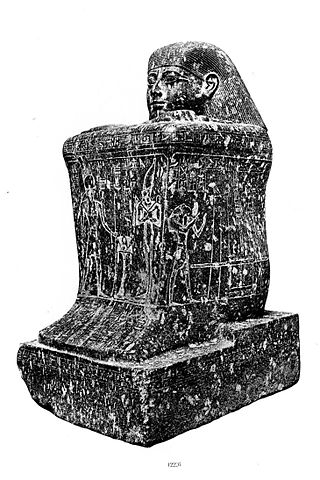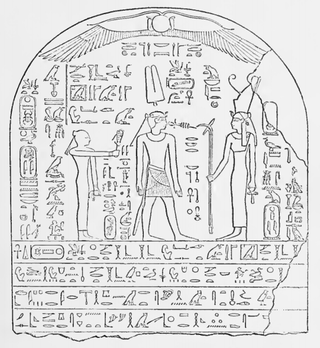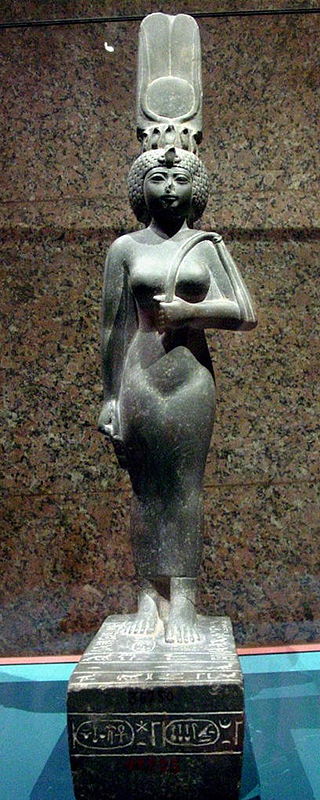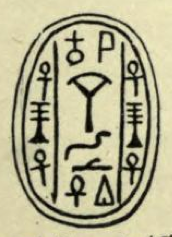| Iuput I | |
|---|---|
| Pharaoh | |
| Reign | uncertain |
| Coregency | Pedubast I |
| Father | Pedubast I |
| Dynasty | 23rd Dynasty |
Iuput I (or Auput I) was an ancient Egyptian co-regent of his father pharaoh Pedubast I during the early 23rd Dynasty.
| Iuput I | |
|---|---|
| Pharaoh | |
| Reign | uncertain |
| Coregency | Pedubast I |
| Father | Pedubast I |
| Dynasty | 23rd Dynasty |
Iuput I (or Auput I) was an ancient Egyptian co-regent of his father pharaoh Pedubast I during the early 23rd Dynasty.
The exact dates of his coregency are unknown. It started possibly around 815 BC, or alternatively in the final couple of years of his father's reign; one authority provides the dates circa 816 to 800 BC. [2] His highest date is a regnal year 12 found carved in an inscription on the roof of the Khonsu Temple at Karnak. [3] A year 9 is also attested for him on the roof of the temple. Helen Jacquet-Gordon published a transcription of Iuput I's Years 9 and 12 of the Khonsu temple graffito, in which it is named "Graffito 244" and "Graffito 245A-B". [3]
The 1290s BC is a decade which lasted from 1299 BC to 1290 BC.

Usermaatre Setepenre Meryamun Ramesses VII was the sixth pharaoh of the 20th Dynasty of Ancient Egypt. He reigned from about 1136 to 1129 BC and was the son of Ramesses VI. Other dates for his reign are 1138–1131 BC. The Turin Accounting Papyrus 1907+1908 is dated to Year 7 III Shemu day 26 of his reign and has been reconstructed to show that 11 full years passed from Year 5 of Ramesses VI to Year 7 of his reign.

Usermaatre Setepenamun Osorkon II was the fifth king of the Twenty-second Dynasty of Ancient Egypt and the son of King Takelot I and Queen Kapes. He ruled Egypt from approximately 872 BC to 837 BC from Tanis, the capital of that dynasty.

Mentuhotep I may have been a Theban nomarch and independent ruler of Upper Egypt during the early First Intermediate Period. Alternatively, Mentuhotep I may be a fictional figure created during the later Eleventh Dynasty, which rose to prominence under Intef II and Mentuhotep II, playing the role of a founding father.

Djedhotepre Dedumose I was an Egyptian pharaoh of the Second Intermediate Period. According to egyptologists Kim Ryholt, Darrell Baker, Aidan Dodson and Dyan Hilton, he was a king of the 16th Dynasty. Alternatively, Jürgen von Beckerath, Thomas Schneider and Detlef Franke see him as a king of the 13th Dynasty.

Merenre Nemtyemsaf II was an ancient Egyptian pharaoh, the sixth and penultimate ruler of the 6th Dynasty. He reigned for 1 year and 1 month in the first half of the 22nd century BC, at the very end of the Old Kingdom period. Nemtyemsaf II likely ascended the throne as an old man, succeeding his long-lived father Pepi II Neferkare at a time when the power of the pharaoh was crumbling.

Heqakheperre Shoshenq II or Shoshenq IIa was a pharaoh of the Twenty-second Dynasty of Egypt. He was the only ruler of this dynasty whose tomb was not plundered by tomb robbers. His final resting place was discovered within an antechamber of Psusennes I's tomb at Tanis by Pierre Montet in 1939. Montet removed the coffin lid of Shoshenq II on March 20, 1939, in the presence of king Farouk of Egypt himself. It proved to contain many jewel-encrusted bracelets and pectorals, along with a beautiful hawkheaded silver coffin and a gold funerary mask. The facemask had been placed upon the head of the king. Montet later discovered the intact tombs of two Twenty-first Dynasty kings a year later in February and April 1940 respectively. Shoshenq II's prenomen, Heqakheperre Setepenre, means "The manifestation of Ra rules, the chosen one of Ra."

Jürgen von Beckerath was a German Egyptologist. He was a prolific writer who published countless articles in journals such as Orientalia, Göttinger Miszellen (GM), Journal of the American Research Center in Egypt (JARCE), Archiv für Orientforschung (AfO), and Studien zur Altägyptischen Kultur (SAK) among others. Together with Kenneth Kitchen, he is viewed as one of the foremost scholars on the New Kingdom and the Third Intermediate Period of Egypt.

Shoshenq VI is known to be Pedubast I's immediate successor at Thebes based upon the career of the Letter Writer to Pharaoh Hor IX, who served under Osorkon II and Pedubast I. Since Shoshenq VI's prenomen is inscribed on Hor IX's funerary cones, this indicates that Hor IX outlived Pedubast I and made his funeral arrangements under Shoshenq VI instead. His prenomen or royal name was "Usermaatre Meryamun Shoshenq" which is unusual because it is the only known example where the epithet "Meryamun" appears within a king's cartouche. Shoshenq VI's High Priest of Amun was a certain Takelot who first appears in office in Year 23 of Pedubast I.

Menkheperre Ini was an Egyptian king reigning at Thebes during the 8th century BC following the last king of the 23rd Dynasty, Rudamun.

Usermaatre Setepenamun Osorkon III Si-Ese was Pharaoh of Egypt in the 8th Century BC. He is the same person as the Crown Prince and High Priest of Amun Osorkon B, son of Takelot II by his Great Royal Wife Karomama II. Prince Osorkon B is best attested by his Chronicle—which consists of a series of texts documenting his activities at Thebes—on the Bubastite Portal at Karnak. He later reigned as king Osorkon III in Upper Egypt for twenty-eight years after defeating the rival forces of Pedubast I/Shoshenq VI who had apparently resisted the authority of his father here. Osorkon ruled the last five years of his reign in coregency with his son, Takelot III, according to Karnak Nile Level Text No. 13. Osorkon III's formal titulary was long and elaborate: Usermaatre Setepenamun, Osorkon Si-Ese Meryamun, Netjer-Heqa-waset.

Sekhemre Wahkhau Rahotep was an Egyptian pharaoh who reigned during the Second Intermediate Period, when Egypt was ruled by multiple kings. The Egyptologists Kim Ryholt and Darrell Baker believe that Rahotep was the first king of the 17th Dynasty.

Ankhnesneferibre was an ancient Egyptian princess and priestess during the 26th Dynasty, daughter of pharaoh Psamtik II and his queen Takhuit. She held the positions of Divine Adoratrice of Amun and later God's Wife of Amun between 595 and 525 BC, during the reigns of Psamtik II, Apries, Amasis II and Psamtik III, until the Achaemenid conquest of Egypt.
Setut or Senen... was a pharaoh of the 9th Dynasty of ancient Egypt.

Seankhenre Mentuhotepi was an ancient Egyptian pharaoh during the fragmented Second Intermediate Period. According to egyptologists Kim Ryholt and Darrell Baker, he was the fifth king of the 16th Dynasty reigning over the Theban region in Upper Egypt. Alternatively, Jürgen von Beckerath sees him as the fifth king of the 17th Dynasty.

Mershepsesre Ini was a pharaoh of the late 13th Dynasty, possibly the forty-sixth king of this dynasty. He reigned over Upper Egypt during the mid-17th century BC.

Wazad was an Egyptian pharaoh during the Second Intermediate Period. According to the Egyptologists Kim Ryholt and Darrell Baker, Wazad was a member of the 14th Dynasty of Egypt reigning c. 1700 BC. As a king of the 14th Dynasty, he would have reigned from Avaris over the eastern Nile Delta and possibly over the western Delta as well. The Memphis-based 13th Dynasty reigned over Middle and Upper Egypt at the same time. Alternatively, according to Jürgen von Beckerath and Wolfgang Helck, Wazad was a ruler of the 16th Dynasty and a vassal of the Hyksos 15th Dynasty. This view is debated in Egyptology, in particular because Ryholt and others have argued that the 16th Dynasty was an independent Theban kingdom rather than a vassal dynasty of the Hyksos.

Sewahenre Senebmiu is a poorly attested Egyptian pharaoh during the Second Intermediate Period, thought to belong to the late 13th Dynasty.

Sekheperenre was an Egyptian pharaoh of the 14th Dynasty of Egypt during the Second Intermediate Period. According to the Egyptologists Kim Ryholt and Darrell Baker, Sekheperenre was the twenty-second king of the dynasty; alternatively, Jürgen von Beckerath sees him as the seventeenth ruler. As a king of the 14th Dynasty, Sekheperenre would have reigned from Avaris over the eastern Nile Delta and possibly over the western Delta as well.

Gemenefkhonsbak was an ancient Egyptian ruler ("king") of Tanis during the 25th Dynasty.